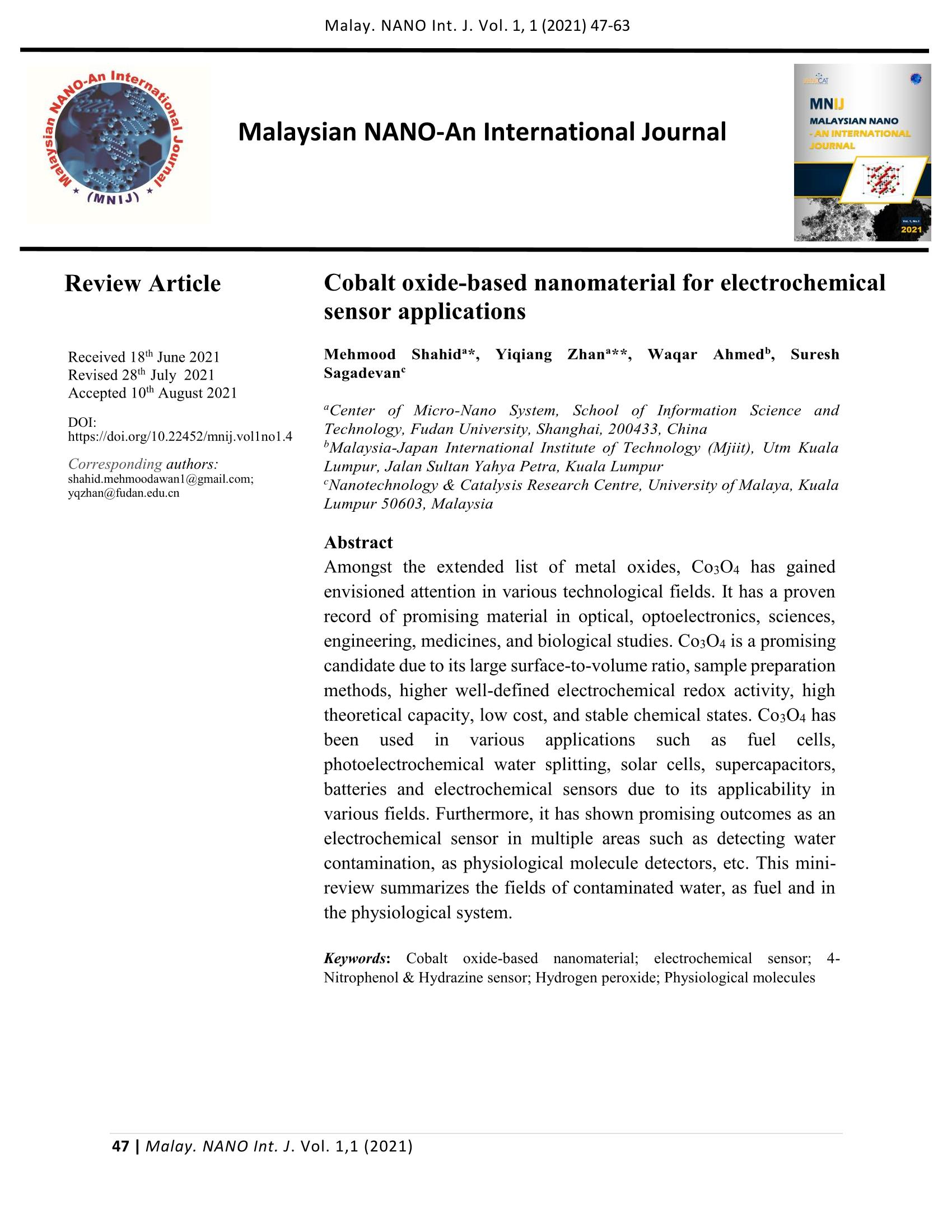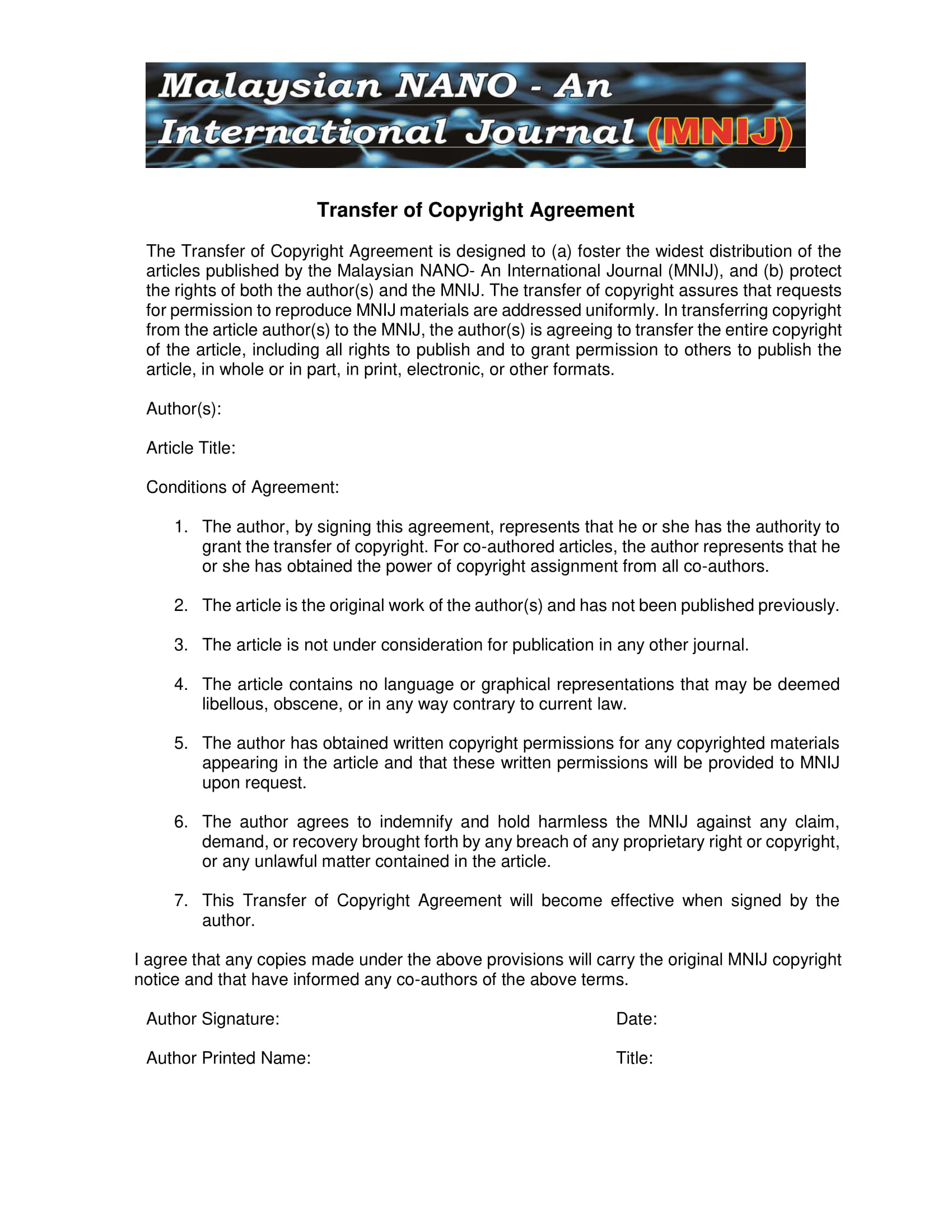Cobalt oxide-based nanomaterial for electrochemical sensor applications
A mini review
DOI:
https://doi.org/10.22452/mnij.vol1no1.4Keywords:
Cobalt oxide-based nanomaterial, Electrochemical sensor, 4-Nitrophenol & Hydrazine sensor, Hydrogen peroxide, Physiological moleculesAbstract
Amongst the extended list of metal oxides, Co3O4 has gained envisioned attention in various technological fields. It has a proven record of promising material in optical, optoelectronics, sciences, engineering, medicines and biological fields of studies. Co3O4 is a promising candidate due to its large surface-to-volume ratio, simple preparation methods, higher well-defined electrochemical redox activity, high theoretical capacity, low cost, and stable chemical states. Co3O4 has been used in various applications such as fuel cells, photoelectrochemical water splitting, solar cells, supercapacitors, batteries and electrochemical sensors due to its applicability in various fields. It has shown promising outcomes as an electrochemical sensor in various areas such as in the detection of water contamination, as physiological molecule detectors etc. this mini-review summarizes the fields of contaminated water, as fuel and also in the physiological system.
Downloads
References
Guth, U., W. Vonau, and J. Zosel. Recent developments in electrochemical sensor application and technology—a review. Measurement Science and Technology. 2009; 20(4): 042002.
Kaur, G., A. Kaur, and H. Kaur. Review on nanomaterials/conducting polymer-based nanocomposites for the development of biosensors and electrochemical sensors. Polymer-Plastics Technology and Materials. 2021; 60(5): 502-519.
Pardieu, E., et al., Molecularly imprinted conducting polymer-based electrochemical sensor for detection of atrazine. Analytica Chimica Acta. 2009; 649(2): 236-245.
Krishnan, R.G., et al. Mixed metal oxide-based electrochemical sensing of inhibitory neurotransmitter serotonin in the presence of dopamine. in IOP Conference Series: Materials Science and Engineering. 2020. IOP Publishing.
Yusoff, N., et al., Amperometric detection of nitric oxide using a glassy carbon electrode modified with gold nanoparticles incorporated into a nanohybrid composed of reduced graphene oxide and Nafion. Microchimica Acta. 2017; 184(9): 3291-3299.
Shahid, M.M., et al., An electrochemical sensing platform based on a reduced graphene oxide–cobalt oxide nanocube@ platinum nanocomposite for nitric oxide detection. Journal of Materials Chemistry A. 2015; 3(27): 14458-14468.
Shahid, M.M., P. Rameshkumar, and N.M. Huang, Morphology dependent electrocatalytic properties of hydrothermally synthesized cobalt oxide nanostructures. Ceramics International. 2015; 41(10):13210-13217.
Fazio, E., et al., Metal-Oxide Based Nanomaterials: Synthesis, Characterization and Their Applications in Electrical and Electrochemical Sensors. Sensors. 2021; 21(7): 2494.
Agnihotri, A.S., A. Varghese, and M. Nidhin, Transition metal oxides in electrochemical and biosensing: A state-of-art review. Applied Surface Science Advances. 2021; 4: 100072.
Qiu, J., S. Zhang, and H. Zhao, Recent applications of TiO2 nanomaterials in chemical sensing in aqueous media. Sensors and Actuators B: Chemical. 2011; 160(1): 875-890.
Shetti, N.P., et al., ZnO-based nanostructured electrodes for electrochemical sensors and biosensors in biomedical applications. Biosensors and Bioelectronics. 2019; 141: 111417.
Anitha, A., et al., WO3 nanoparticles based direct electrochemical dopamine sensor in the presence of ascorbic acid. Electrochimica Acta. 2015; 167: 294-302.
Cao, X. and N. Wang, A novel non-enzymatic glucose sensor modified with Fe2O3 nanowire arrays. Analyst. 2011; 136(20): 4241-4246.
Khatoon, Z., et al., Doped SnO2 nanomaterials for e-nose based electrochemical sensing of biomarkers of lung cancer. ACS omega. 2020; 5(42): 27645-27654.
Avinash, B., et al., Nano CuO: Electrochemical sensor for the determination of paracetamol and D-glucose. Journal of Physics and Chemistry of Solids. 2019; 134: 193-200.
Reza, K.K., et al., Pearl shaped highly sensitive Mn3O4 nanocomposite interface for biosensor applications. Biosensors and Bioelectronics. 2014; 62: 47-51.
Shepa, J., et al., NiO Nanoparticles for Electrochemical Insulin Detection. Sensors. 2021; 21(15): 5063.
Zhou, T., et al., Electrochemical sensors based on semiconductor nanostructures modified electrodes. Science of Advanced Materials. 2015; 7(10): 2069-2083.
San, X., et al., Flower-like NiO hierarchical microspheres self-assembled with nanosheets: Surfactant-free solvothermal synthesis and their gas sensing properties. Journal of Alloys and Compounds. 2015; 636: 357-362.
Zhang, L., et al., Novel Mn3O4 Micro-octahedra: Promising Cataluminescence Sensing Material for Acetone. Chemistry of Materials. 2009; 21(21): 5066-5071.
Hu, X., et al., Reviews and Prospectives of Co3O4‐Based Nanomaterials for Supercapacitor Application. Chemistry Select. 2020; 5(17): 5268-5288.
Needham, S.A., et al., Electrochemical performance of Co3O4–C composite anode materials. Electrochemical and Solid-State Letters. 2006; 9(7): A315.
Hayakawa, Y., et al., Magnetism of diluted Co3O4 nanocrystals. Physica E: Low-dimensional Systems and Nanostructures. 2001; 9(2): 250-252.
Shahid, M.M., et al., A cobalt oxide nanocubes interleaved reduced graphene oxide nanocomposite modified glassy carbon electrode for amperometric detection of serotonin. Materials Science and Engineering: C. 2019; 100: 388-395.
Shahid, M.M., et al., An electrochemical sensing platform of cobalt oxide@ gold nanocubes interleaved reduced graphene oxide for the selective determination of hydrazine. Electrochimica Acta. 2018; 259: 606-616.
Shahid, M.M., et al., Cobalt oxide nanocubes interleaved reduced graphene oxide as an efficient electrocatalyst for oxygen reduction reaction in alkaline medium. Electrochimica Acta. 2017; 237: 61-68.
Sagadevan, S., et al., Reduced graphene/nanostructured cobalt oxide nanocomposite for the enhanced electrochemical performance of supercapacitor applications. Journal of colloid and interface science. 2020; 558: 68-77.
Shahid, M.M., et al., A single-step synthesis of nitrogen-doped graphene sheets decorated with cobalt hydroxide nanoflakes for the determination of dopamine. Progress in Natural Science: Materials International. 2017; 27(5): 582-587.
Itteboina, R. and T.K. Sau, Sol-gel synthesis and characterizations of morphology-controlled Co3O4 particles. Materials Today: Proceedings. 2019; 9: 458-467.
Janjua, M.R.S.A., Synthesis of Co3O4 nano aggregates by Co-precipitation method and its catalytic and fuel additive applications. Open Chemistry. 2019; 17(1): 865-873.
Madhu, R., et al., Electrochemical detection of 4-nitrophenol based on biomass-derived activated carbons. Analytical Methods. 2014; 6(14): 5274-5280.
Punjiya, M., et al., A three-dimensional electrochemical paper-based analytical device for low-cost diagnostics. Analyst. 2018; 143(5): 1059-1064.
Liu, B., et al., Electrochemical analysis of p-nitrophenol in acidic or alkaline medium using silver nanoparticle decorated multi-walled carbon nanotubes. Journal of Materials Science. 2014; 49(15): 5398-5405.
Krittayavathananon, A., et al., Palladium nanoparticles decorated on reduced graphene oxide rotating disk electrodes toward ultrasensitive hydrazine detection: effects of particle size and hydrodynamic diffusion. Analytical chemistry. 2014; 86(24): 12272-12278.
Cui, L., et al., Unique tri-output optical probe for specific and ultrasensitive detection of hydrazine. Analytical chemistry. 2014; 86(9): 4611-4617.
Cui, L., et al., Hydrazine detection in the gas state and aqueous solution based on the Gabriel mechanism and its imaging in living cells. Chemical Communications. 2014; 50(12): 1485-1487.
Dai, G., et al., Flower-like Co3O4/graphitic carbon nitride nanocomposite based electrochemical sensor and its highly sensitive electrocatalysis of hydrazine. Journal of Alloys and Compounds. 2017; 727: 43-51.
Zhou, T., et al., Perforated Co3O4 nanoneedles assembled in chrysanthemum-like Co3O4 structures for ultra-high sensitive hydrazine chemical sensor. Sensors and Actuators B: Chemical, 2016. 235: 457-465.
Zhang, J., et al., Nanorod-constructed porous Co3O4 nanowires: highly sensitive sensors for the detection of hydrazine. Analyst. 2015; 140(5): 1686-1692.
Ding, J., et al., Hydrothermal synthesis of zinc oxide-reduced graphene oxide nanocomposites for an electrochemical hydrazine sensor. RSC Advances. 2015; 5(29): 22935-22942.
Madhu, R., et al., An electrochemical synthesis strategy for composite-based ZnO microspheres–Au nanoparticles on reduced graphene oxide for the sensitive detection of hydrazine in water samples. RSC Advances. 2015; 5(67): 54379-54386.
Choudhary, G., et al., Toxicological profile for hydrazines. 1997.
Karimi-Maleh, H., et al., An electrochemical nanocomposite modified carbon paste electrode as a sensor for simultaneous determination of hydrazine and phenol in water and wastewater samples. Environmental Science and Pollution Research. 2014; 21(9): 5879-5888.
Shahid, M.M., P. Rameshkumar, and N.M. Huang, A glassy carbon electrode modified with graphene oxide and silver nanoparticles for amperometric determination of hydrogen peroxide. Microchimica Acta. 2016; 183(2): 911-916.
Wang, M., et al., Highly sensitive H2O2 sensor based on Co3O4 hollow sphere prepared via a template-free method. Electrochimica Acta. 2015; 182: 613-620.
Watt, B.E., A.T. Proudfoot, and J.A. Vale, Hydrogen peroxide poisoning. Toxicological reviews. 2004; 23(1): 51-57.
Lei, W., et al., Detection of hydrogen peroxide in river water via a microplate luminescence assay with time-resolved (“gated”) detection. Microchimica Acta. 2003; 143(4): 269-274.
Pinkernell, U., S. Effkemann, and U. Karst, Simultaneous HPLC determination of peroxyacetic acid and hydrogen peroxide. Analytical chemistry. 1997; 69(17): 3623-3627.
Guo, S., et al., Gold nanowire assembling architecture for H2O2 electrochemical sensor. Talanta. 2009; 77(4): 1510-1517.
Lim, S.P., et al., Amperometric detection of hydrogen peroxide and its density functional theory for adsorption on Ag/TiO2 nanohybrid. Journal of Materials Science: Materials in Electronics. 2020; 31(8): 6017-6026.
Cao, G.S., et al., Non-enzymatic hydrogen peroxide sensor based on Co3O4 nanocubes. Bulletin of Materials Science. 2014; 37(6): 1369-1373.
Numan, A., et al., Binary nanocomposite based on Co3O4 nanocubes and multiwalled carbon nanotubes as an ultrasensitive platform for amperometric determination of dopamine. Microchimica Acta, 2017. 184(8): 2739-2748.
Mazloum-Ardakani, M., et al., Voltammetric determination of dopamine at the surface of TiO2 nanoparticles modified carbon paste electrode. Int. J. Electrochem. Sci. 2010; 5: 147-157.
Obata, T., Dopamine efflux by MPTP and hydroxyl radical generation. Journal of neural transmission. 2002; 109(9): 1159-1180.
Ensafi, A.A., M. Taei, and T. Khayamian, A differential pulse voltammetric method for simultaneous determination of ascorbic acid, dopamine, and uric acid using poly (3-(5-chloro-2-hydroxyphenylazo)-4, 5-dihydroxy naphthalene-2, 7-disulfonic acid) film modified glassy carbon electrode. Journal of Electroanalytical Chemistry. 2009; 633(1): 212-220.
Wightman, R.M., L.J. May, and A.C. Michael, Detection of dopamine dynamics in the brain. Analytical chemistry. 1988; 60(13): 769A-793A.
Elhag, S., et al., Dopamine wide range detection sensor based on modified Co3O4 nanowires electrode. Sensors and Actuators B: Chemical., 2014; 203: 543-549.

Downloads
Published
How to Cite
Issue
Section
License





